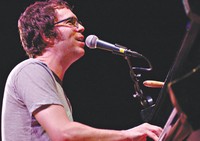Triads
One, Three, Five
In a Major Scale, use every other note, up to the 5th note, to make a triad:
Every other note from start to fifth, is:
This forms a triad. These three notes sound pleasant when played together, because they're all in the key of D Major.
Chord Key

ben folds
Why do we need Triads? They form a basic Chord. Chords may start in any key. They're strung together in different patterns to make a song.
Therefore, to improvise a melody, we must know our Key (which notes to sharp or flat). First, we find our Chord's root, called Tonic, or the 1st note of a scale.
Within a song, a chord's root is one note to which the other notes revolve around, or resolve to, in sound. We play or sing some notes we hear in a particular chord. Then we play up or down its key's scale, to reach the bottom or top root note.
In a song's basic form, the triads form a chord, the root changes periodically, and the melody follows the chord's key for its notes. This key changes, and the melody follows the new key.
Now that we've located our root, we need its key signature to know which triad notes to sharp or flat.
If the root note is E, then E Major is a Key with sharps. Using the sharps rule:
First, move E down a half step, to D#. Second, with the Order of Sharps, count up to D# :
FCGD notes are sharp now.
Use these sharps in the E Major Scale alphabet, with E as Root:
Now, let's make our Triad: Every other note up to the Fifth (5th) note is:
That makes the E triad.
- E = root
- D#: 1/2 step below E
- F C G D sharps
For a simpler method, count every other note in the E scale:
Then, find the Key Signature for the correct Sharp notes in the E Major triad:
Additionally, Triads help us to play a solo, or improvise, since we need a reference for the patterns we play. The anchors of first, third, or fifth notes marks our location in a scale.
Triads give a melodic structure, inspiring other scale types, key change prediction, and arpeggio (note pattern) creation.
Finally, Triads are both shortcuts to remember a Key, and also chords that change within a song.
Recommended reading: More about Triads
The next page is about modes that alter notes to modify a key's sound.